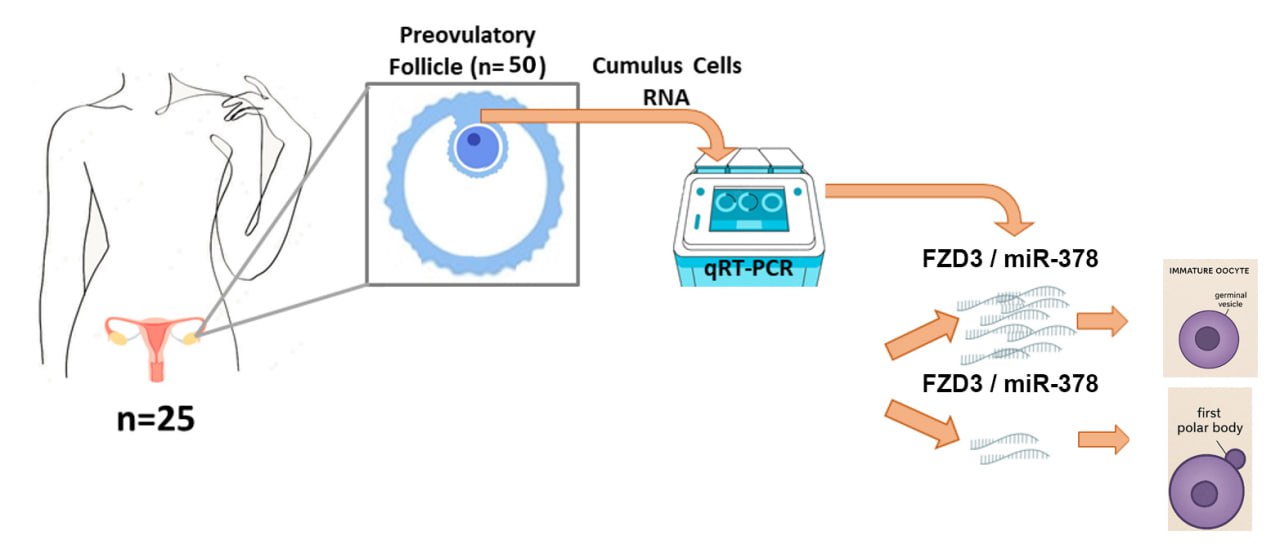Sun, Dec 14, 2025
[Archive]
Volume 23, Issue 3 (March 2025)
IJRM 2025, 23(3): 265-274 |
Back to browse issues page
Ethics code: IR.SSU.MEDICINE.REC.1402.291
Download citation:
BibTeX | RIS | EndNote | Medlars | ProCite | Reference Manager | RefWorks
Send citation to:



BibTeX | RIS | EndNote | Medlars | ProCite | Reference Manager | RefWorks
Send citation to:
Bagheri A M, Monshizadeh K, Anbari F, Ghasemi N, Dehghani M. Evaluation of frizzled class receptor 3 and miR-378 expression levels in cumulus cells of polycystic ovary syndrome women: A case-control study. IJRM 2025; 23 (3) :265-274
URL: http://ijrm.ir/article-1-3506-en.html
URL: http://ijrm.ir/article-1-3506-en.html
Amir Mohmmad Bagheri1 

 , Kimia Monshizadeh1
, Kimia Monshizadeh1 

 , Fatemeh Anbari2
, Fatemeh Anbari2 

 , Nasrin Ghasemi3
, Nasrin Ghasemi3 

 , Mohammadreza Dehghani *4
, Mohammadreza Dehghani *4 




 , Kimia Monshizadeh1
, Kimia Monshizadeh1 

 , Fatemeh Anbari2
, Fatemeh Anbari2 

 , Nasrin Ghasemi3
, Nasrin Ghasemi3 

 , Mohammadreza Dehghani *4
, Mohammadreza Dehghani *4 


1- Department of Medical Genetics, School of Medicine, Shahid Sadoughi University of Medical Sciences, Yazd, Iran.
2- Research and Clinical Center for Infertility, Yazd Reproductive Sciences Institute, Shahid Sadoughi University of Medical Sciences, Yazd, Iran.
3- Abortion Research Center, Yazd Reproductive Sciences Institute, Shahid Sadoughi University of Medical Sciences, Yazd, Iran.
4- 3. Abortion Research Center, Yazd Reproductive Sciences Institute, Shahid Sadoughi University of Medical Sciences, Yazd, Iran. ,mrdehghani@ssu.ac.ir
2- Research and Clinical Center for Infertility, Yazd Reproductive Sciences Institute, Shahid Sadoughi University of Medical Sciences, Yazd, Iran.
3- Abortion Research Center, Yazd Reproductive Sciences Institute, Shahid Sadoughi University of Medical Sciences, Yazd, Iran.
4- 3. Abortion Research Center, Yazd Reproductive Sciences Institute, Shahid Sadoughi University of Medical Sciences, Yazd, Iran. ,
Abstract: (675 Views)
Background: Polycystic ovarian syndrome (PCOS) is a common endocrine disorder that affects women of reproductive age. Recent studies suggest that frizzled class receptor 3 (FZD3) and miR-378 play significant roles in PCOS by affecting oocyte maturation.
Objective: Considering the importance of FZD3 and miR-378 in ovulation, the present study aimed to determine the expression levels of FZD3 and miR-378 genes in cumulus cells of germinal vesicles and metaphase II oocytes in women with PCOS.
Materials and Methods: The samples for this case-control study included, randomly selected, 25 women with PCOS who were treated at the Research and Clinical Center for Infertility, Yazd, Iran. The diagnosis of PCOS was made based on the criteria defined in the Rotterdam guidelines. Quantitative real-time polymerase chain reaction determined the expression level of FZD3 and miR-378.
Results: This study showed increased expression of FZD3 and miR-378 in cumulus cells of immature oocytes compared to mature oocytes (p < 0.0001).
Conclusion: High levels of FZD3 and miR-378 in cumulus cells of immature oocytes can inhibit their maturation. FZD3, a component of the WNT signaling pathway, is overexpressed in immature oocytes and may negatively affect the maturation process. Additionally, miR-378 inhibits oocyte development by targeting and repressing essential genes. Currently, various aspects of microRNA function remain unknown. MiR-378 may exert its regulatory role by directly targeting the FZD3 gene or by targeting other genes and mediators that interact with FZD3 or the protein it encodes. This study may provide a foundation for further investigation of this hypothesis in future research.
Objective: Considering the importance of FZD3 and miR-378 in ovulation, the present study aimed to determine the expression levels of FZD3 and miR-378 genes in cumulus cells of germinal vesicles and metaphase II oocytes in women with PCOS.
Materials and Methods: The samples for this case-control study included, randomly selected, 25 women with PCOS who were treated at the Research and Clinical Center for Infertility, Yazd, Iran. The diagnosis of PCOS was made based on the criteria defined in the Rotterdam guidelines. Quantitative real-time polymerase chain reaction determined the expression level of FZD3 and miR-378.
Results: This study showed increased expression of FZD3 and miR-378 in cumulus cells of immature oocytes compared to mature oocytes (p < 0.0001).
Conclusion: High levels of FZD3 and miR-378 in cumulus cells of immature oocytes can inhibit their maturation. FZD3, a component of the WNT signaling pathway, is overexpressed in immature oocytes and may negatively affect the maturation process. Additionally, miR-378 inhibits oocyte development by targeting and repressing essential genes. Currently, various aspects of microRNA function remain unknown. MiR-378 may exert its regulatory role by directly targeting the FZD3 gene or by targeting other genes and mediators that interact with FZD3 or the protein it encodes. This study may provide a foundation for further investigation of this hypothesis in future research.
Keywords: Gene expression regulation, Polycystic ovary syndrome, Cumulus cells, Wnt signaling pathway.
Type of Study: Original Article |
Subject:
Reproductive Genetics
Send email to the article author
| Rights and permissions | |
 |
This work is licensed under a Creative Commons Attribution-NonCommercial 4.0 International License. |





